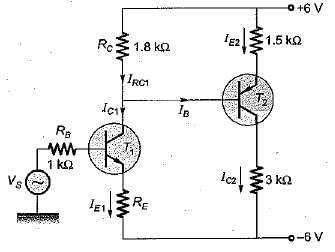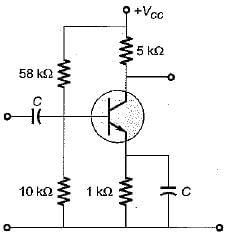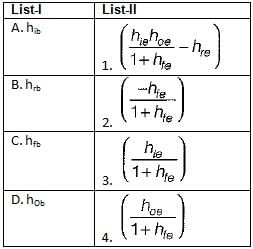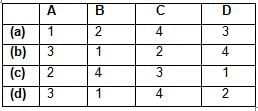Test: BJT As an Amplifier- 2 - Electronics and Communication Engineering (ECE) MCQ
15 Questions MCQ Test - Test: BJT As an Amplifier- 2
The value of input impedance and voltage gain of the common base circuit shown below are respectively (Take VBE = 0.6 V)


The circuit shown in figure is biased such that VCE2 = 0 when VS = 0. Neglecting the base current of both transistors and forward bias across VBE for both transistors to be 0.7, the value of RE would be equal to


A cascade stage is shown in figure below. If the transconductance of T1 and T2 are gm1 = ic1 / Vbe1 and gm2 = ic2 / Vbe2, the overall transconductance gm = ic2 / Vbe1 is


An emitter follower with β = 100 is biased at IC - 0.25 mA. The voltage source connected at its input has its internal resistance of 2 kΩ What is the value of RE such that it produces the output resistance of 110 Ω (Take VT = 25 mV)
Two stages of BJT amplifiers are cascaded by RC coupling. The voltage gain of the first stage is 20 and that of the second stage is 30. The overall gain of the coupled amplifier is
The main characteristics of a Darlington amplifier are
Which of the following parameters is used for distinguishing between a small signal and a large-signal amplifier?
Consider the following statements:
1. The coupling capacitor mainly affect the lower cutoff frequency.
2. The phase reversal between output and input takes place only for voltage wave and not for current waves, in a transistor amplifier in CE mode.
3. The DC collector current in a transistor circuit is limited by the junction capacitance.
4. Negative DC feedback through RE is responsible for the stabilization of the operating point in a potential divider bias circuit.
Of these statement:
A transistor has hfe = 100, hte = 5.2 kΩ, and rbb, = 0. At room temperature VT = 26 mV. The collector current |IC| will be
A transistor is used in common emitter mode in an amplifier circuit. When a signal of 30 mV is added to the base emitter voltage, the base current changes by 30 μA and collector current by 3 mA. The load resistance is 5 kΩ. The value of transconductance and voltage gain is given by
The transistor in the amplifier shown has the following parameters:
hfe = 100, hie = 2 kΩ, hre = 0, hoe = 0.05 m Mho.
'C’ is very large. The output impedance is

If RS is the source resistance, the output resistance of an emitter-follower using the simplified hybrid model would be
In the CE amplifier with RL = 4000 Ω, given that  The current gain |Ai| is
The current gain |Ai| is
Assertion (A): On extending the hybrid model for two-port network to a transistor it is assumed that the signal excursion about the Q-point is small.
Reason (R): Small signal operation is that in which the AC input signal voltages and currents are in order of ±10% of Q-point voltage and currents.
For a common-collector configuration of an n-p-n transistors, the hybrid parameters are given as:
hic = hie, hrc = - 1, hfc = - (1 + hfe) and hoc = hoe.
Match List-I (Hybrid parameters of CB configuration) with List-II (Values) and select the correct answer using the codes given below the lists:

Codes:





























































